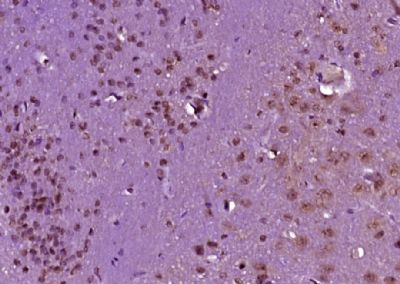CWC22 Polyclonal Antibody
Purified Rabbit Polyclonal Antibody (Pab)
- SPECIFICATION
- CITATIONS
- PROTOCOLS
- BACKGROUND

Application
| IHC-P, IHC-F, IF, ICC, E |
|---|---|
| Primary Accession | Q9HCG8 |
| Reactivity | Rat, Pig, Dog, Bovine |
| Host | Rabbit |
| Clonality | Polyclonal |
| Calculated MW | 105 KDa |
| Physical State | Liquid |
| Immunogen | KLH conjugated synthetic peptide derived from human CWC22 |
| Epitope Specificity | 101-200/908 |
| Isotype | IgG |
| Purity | affinity purified by Protein A |
| Buffer | 0.01M TBS (pH7.4) with 1% BSA, 0.02% Proclin300 and 50% Glycerol. |
| SUBCELLULAR LOCATION | Nucleus. |
| SIMILARITY | Belongs to the CWC22 family. Contains 1 MI domain. Contains 1 MIF4G domain. |
| SUBUNIT | Component of the spliceosome C complex. |
| Important Note | This product as supplied is intended for research use only, not for use in human, therapeutic or diagnostic applications. |
| Background Descriptions | Spliceosomes are multi-protein complexes that are composed of snRNPs (small nuclear ribonucleoproteins) and a variety of associated protein factors, all of which work in concert to regulate the splicing of pre-mRNA, a critical step in the post-transcriptional regulation of gene expression. CWC22 (CWC22 spliceosome-associated protein), also known as NCM, fSAPb or EIF4GL, is a 908 amino acid nuclear protein and component of the spliceosome C complex. CWC22 is associated with the spliceosome prior to catalytic steps and remains associated throughout the reaction. Belonging to the CWC22 family, CW22 contains one MI domain and a MIF4G domain. The gene encoding CWC22 maps to human chromosome 2q31.3. As the second largest human chromosome, chromosome 2 makes up approximately 8% of the human genome and contains 237 million bases encoding over 1,400 genes. |
| Gene ID | 57703 |
|---|---|
| Other Names | Pre-mRNA-splicing factor CWC22 homolog, Nucampholin homolog, fSAPb, CWC22, KIAA1604, NCM |
| Dilution | IHC-P=1:100-500,IHC-F=1:100-500,ICC=1:100-500,IF=1:100-500,ELISA=1:5000-10000 |
| Storage | Store at -20 ℃ for one year. Avoid repeated freeze/thaw cycles. When reconstituted in sterile pH 7.4 0.01M PBS or diluent of antibody the antibody is stable for at least two weeks at 2-4 ℃. |
| Name | CWC22 |
|---|---|
| Synonyms | KIAA1604, NCM |
| Function | Required for pre-mRNA splicing as component of the spliceosome (PubMed:11991638, PubMed:12226669, PubMed:22961380, PubMed:28076346, PubMed:28502770, PubMed:29301961, PubMed:29360106). As a component of the minor spliceosome, involved in the splicing of U12- type introns in pre-mRNAs (Probable). Promotes exon-junction complex (EJC) assembly (PubMed:22959432, PubMed:22961380). Hinders EIF4A3 from non-specifically binding RNA and escorts it to the splicing machinery to promote EJC assembly on mature mRNAs. Through its role in EJC assembly, required for nonsense-mediated mRNA decay. |
| Cellular Location | Nucleus. Nucleus speckle. Note=Concentrates around speckles, which are sites of pre-mRNA synthesis and processing, where it colocalizes with EJC core proteins. |

Thousands of laboratories across the world have published research that depended on the performance of antibodies from Abcepta to advance their research. Check out links to articles that cite our products in major peer-reviewed journals, organized by research category.
info@abcepta.com, and receive a free "I Love Antibodies" mug.
Provided below are standard protocols that you may find useful for product applications.
If you have used an Abcepta product and would like to share how it has performed, please click on the "Submit Review" button and provide the requested information. Our staff will examine and post your review and contact you if needed.
If you have any additional inquiries please email technical services at tech@abcepta.com.













 Foundational characteristics of cancer include proliferation, angiogenesis, migration, evasion of apoptosis, and cellular immortality. Find key markers for these cellular processes and antibodies to detect them.
Foundational characteristics of cancer include proliferation, angiogenesis, migration, evasion of apoptosis, and cellular immortality. Find key markers for these cellular processes and antibodies to detect them. The SUMOplot™ Analysis Program predicts and scores sumoylation sites in your protein. SUMOylation is a post-translational modification involved in various cellular processes, such as nuclear-cytosolic transport, transcriptional regulation, apoptosis, protein stability, response to stress, and progression through the cell cycle.
The SUMOplot™ Analysis Program predicts and scores sumoylation sites in your protein. SUMOylation is a post-translational modification involved in various cellular processes, such as nuclear-cytosolic transport, transcriptional regulation, apoptosis, protein stability, response to stress, and progression through the cell cycle. The Autophagy Receptor Motif Plotter predicts and scores autophagy receptor binding sites in your protein. Identifying proteins connected to this pathway is critical to understanding the role of autophagy in physiological as well as pathological processes such as development, differentiation, neurodegenerative diseases, stress, infection, and cancer.
The Autophagy Receptor Motif Plotter predicts and scores autophagy receptor binding sites in your protein. Identifying proteins connected to this pathway is critical to understanding the role of autophagy in physiological as well as pathological processes such as development, differentiation, neurodegenerative diseases, stress, infection, and cancer.



